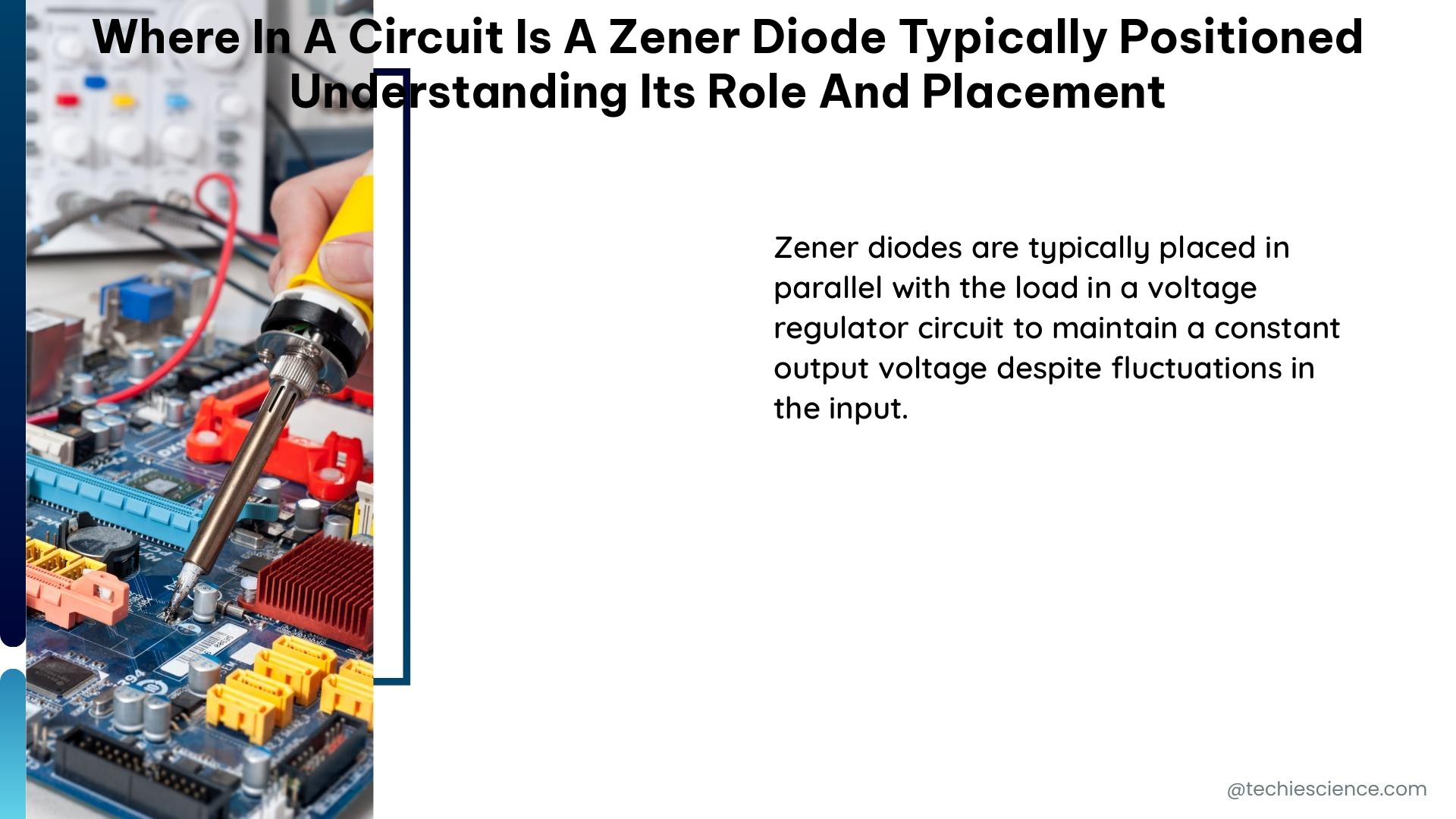Zener diodes are a crucial component in electronic circuits, serving as voltage regulators and references. These semiconductor devices are strategically positioned within circuits to maintain a stable voltage, even in the face of fluctuating input voltages. Understanding the role and placement of Zener diodes is essential for effective circuit design and optimization.
Zener Diode Positioning: Voltage Regulation and Reference
Zener diodes are typically positioned in parallel with the load or component that requires a stable voltage supply. This configuration allows the Zener diode to regulate the voltage across the load, ensuring that the voltage remains constant despite changes in the input voltage or load conditions.
When the input voltage exceeds the Zener diode’s breakdown voltage, the diode enters its reverse-biased mode and begins to conduct. This conduction creates a low-impedance path, effectively clamping the voltage across the load to the Zener voltage. This mechanism ensures that the voltage across the load remains stable, even as the input voltage varies.
Zener Diode Specifications and Characteristics

Zener diodes are characterized by several key specifications that determine their suitability for specific applications:
-
Zener Voltage (Vz): This is the voltage at which the Zener diode enters its reverse-breakdown region. Zener voltages typically range from 2.4 volts to 200 volts, allowing for a wide variety of voltage regulation and reference applications.
-
Maximum Current (Iz(max)): This is the maximum current the Zener diode can handle at its Zener voltage. Typical values range from 200 μA to 200 A, depending on the diode’s power rating and physical size.
-
Minimum Current (Iz(min)): This is the minimum current required to maintain the Zener diode in its reverse-breakdown region. If the current falls below this value, the Zener diode may no longer regulate the voltage effectively.
-
Power Rating: The maximum power the Zener diode can dissipate without exceeding its thermal limits. This is calculated by multiplying the Zener voltage and the current at the Zener voltage.
-
Temperature Stability: Zener diodes exhibit the greatest temperature stability at around 5V, making them well-suited for voltage reference applications where temperature variations are a concern.
-
Voltage Tolerance: Zener diodes typically have a voltage tolerance of ±5%, meaning the actual Zener voltage may vary within this range from the nominal value.
-
Zener Resistance (Rz): This is the dynamic resistance exhibited by the Zener diode in its reverse-breakdown region, which affects the voltage regulation performance.
Zener Diode Circuit Design Example
Let’s consider a practical example of a Zener diode circuit design:
Requirement: Provide a regulated 5.1V rail from a 12V input voltage, with a load current of 2 mA.
Circuit Design:
- Zener Diode Selection: A 5.1V Zener diode with a power rating suitable for the application is chosen.
- Series Resistor Calculation: The series resistor (Rs) is calculated to limit the current through the Zener diode to the desired value. In this case, the series resistor value is 390 Ω.
- Voltage Drop Across Series Resistor: The voltage drop across the series resistor is 6.9V (12V – 5.1V).
- Resistor Current: The current through the series resistor is 15 mA (6.9V / 390 Ω).
- Zener Diode Power Dissipation: The power dissipated by the Zener diode is 76.5 mW (5.1V × 15 mA).
- Total Current Through Series Resistor: The total current through the series resistor is 17 mA (2 mA load current + 15 mA Zener diode current).
To maintain the stability of the Zener diode voltage reference, it is crucial to keep the current flowing through the Zener diode as constant as possible. This can be achieved by using a buffer circuit, such as an emitter or source follower, or by driving the Zener diode with a constant current source.
Zener Diode Placement Considerations
When positioning Zener diodes within a circuit, several factors should be considered:
- Voltage Regulation Requirements: The Zener voltage should be selected based on the specific voltage regulation needs of the circuit. Higher Zener voltages may be required for applications with larger input voltage variations.
- Power Dissipation: The Zener diode’s power rating must be sufficient to handle the expected power dissipation, which is a function of the Zener voltage and the current flowing through the diode.
- Temperature Stability: For applications where temperature stability is critical, Zener diodes with a voltage of around 5.5V should be chosen, as they exhibit the greatest temperature stability.
- Parallel Configuration: Zener diodes are typically placed in parallel with the load or component that requires a stable voltage supply, allowing the Zener diode to regulate the voltage across the load.
- Series Resistor: A series resistor is often used to limit the current flowing through the Zener diode, ensuring that it operates within its safe operating area.
- Buffering and Constant Current: To maintain the stability of the Zener voltage reference, the current flowing through the Zener diode should be kept as constant as possible, which can be achieved through the use of buffer circuits or constant current sources.
Conclusion
Zener diodes play a crucial role in electronic circuits, serving as voltage regulators and references. By understanding their positioning, specifications, and design considerations, engineers can effectively utilize Zener diodes to maintain stable voltage supplies and ensure the reliable operation of their circuits.
Reference:

The lambdageeks.com Core SME Team is a group of experienced subject matter experts from diverse scientific and technical fields including Physics, Chemistry, Technology,Electronics & Electrical Engineering, Automotive, Mechanical Engineering. Our team collaborates to create high-quality, well-researched articles on a wide range of science and technology topics for the lambdageeks.com website.
All Our Senior SME are having more than 7 Years of experience in the respective fields . They are either Working Industry Professionals or assocaited With different Universities. Refer Our Authors Page to get to know About our Core SMEs.